Conservatives fear renewables are a tool of the Left
Prime Minister Tony Abbott doesn’t like wind turbines, and neither does Treasurer Joe Hockey, but it seems like their antipathy towards green energy runs deeper than anyone had suspected – it must be a tool of the Left, and so must be eradicated. It’s hard to find any justification, other than ideology, for the latest broken promises from the Abbott government, the proposed repeal of the Australian Renewable Energy Agency, and the disappearance of the million solar roofs program.
The decision to close ARENA – which means an end to new funding for Australia’s world leading solar research, future support for home-grown technologies in wave energy, battery storage, concentrated solar power and geothermal production – adds to a litany of actions that Abbott has taken since his election victory. The carbon price is going, the $10 billion Clean Energy Finance Corporation is going, the renewable energy target is certain to be either removed or diluted, and now ARENA and a host of energy efficiency and other schemes have been dumped. Indeed, anything that might provide a market signal that we should be making a transformation towards a clean energy economy.
Why Coalition MPs find the thought of melting glaciers amusing
There are two explanations for this – either, in the words of Climate Change Authority chairman Bernie Fraser, it is the result of the government’s “sickening and disappointing” pandering to vested interests, or it is merely continuing the Abbott “climate change is crap” ideological mantra. If you don’t have to address climate issues, then you don’t need to clean up the power supply. Or perhaps it is the result of both.
Liberal Senator Ian Macdonald appeared to speak for the majority of the Coalition MPs and ministers when he took another dig at the climate science in the Senate this week, insisting that the climate is changing, but only “as it has done for literally millions of years”. He noted that one of the reasons the south of Australia is becoming drier is apparently because of “the record amount of sea ice” in Antarctica, which he read about in that august scientific journal, The Australian newspaper.
“That always makes me smile when people talk about global warming,” Macdonald told the Senate. Less amusing, perhaps, were the scientific reports released that same day which showed that the melting of the West Atlantic Ice Cap is now considered irreversible and unstoppable, and could lead to massive rises in sea levels. Probably, however, beyond the Senator’s current parliamentary term, which is about as far as this government is willing to look.
Boganaire, unbowed by “green terrorists”, buys back into coal
That same disregard for climate policy appears to be driving not just conservative policies, but Australian coal barons – both major and minor. One of the lesser barons, Nathan Tinkler, the Newcastle “Boganaire” – as Paddy Manning’s book described him – has dusted himself off from the collapse of his first coal empire and re-entered the market with the proposed $150 million of a thermal coal mine in Queensland – vowing not to be derailed by “terrorist acts by green parties”, or even environmental considerations. He was sure, Tinkler told The Australian, that Australian coal was of such high quality that digging up hundreds of millions of tonnes of it would help the world reduce emissions.
Tinkler may be disappointed to find that it is not green terrorists and “extremists” that threaten coal projects the most, so much as the world’s financial markets and a long term structural decline in the coal industry. The Institute for Energy Economics and Financial Analysis this week noted that thermal coal prices are at a record low. Tinkler thinks that is a great time to buy, unless of course you recognise – as Citigroup suggested this week – that a combination of regulatory and technology changes will force an unstoppable transformation in energy markets. Good luck with the financing.
Conservatives continue grants to “clean” brown coal projects
Despite the death of ARENA and other incentives for renewable, one fund the federal government is continuing to support is the $90 million Advanced Lignite Demonstration Program which it shares with Victoria. The desire to export vast quantities of lignite goes against history, the financial risks identified by the Citigroup reports, and warnings from the International Energy Agency, which this week reminded everyone that coal fired generation must be phased out quickly, and gas-fired generation too from 2025, if the world is to meet climate goals. Standard & Poor’s also issued a new report highlighting increasing “sovereign risk” from climate change.
But, unbowed by what official news outlet The Australian blithely dismissed as “green alarm”, and unabashed by the aforementioned dumping of support for renewables, and its vow to remove “corporate welfare”, the Federal and conservative Victorian governments have decided to chuck $50 million into projects to turn brown coal into diesel and synthetic oils, and to try and create “vast scales” exports of a “higher grade” coal. The Victorian brown coal reserves were of national significance, said Industry minister Ian “we must extract every molecule of gas” Macfarlane.

What do camels and wind farms have in common?
One of the controversial appointments to Tony Abbott’s panel reviewing the renewable energy target (headed by climate change skeptic and pro-nuclear warhorse Dick Warburton) was Brian Fisher, a noted opponent of climate policies while at ABARE and a fossil fuel lobbyist since, who has been taking a very active role in the meetings with industry representatives.
We were quite surprised to learn that Fisher’s company BAEconomics also sponsors a web-site called Adopt a Mongolian Camel, which encourages donors to offer $700 for a camel in inner Mongolia – apparently that’s the market price, although it seems a lot. Donors are afforded the right to visit the camel whenever they please, as long as it is at their own expense and it’s OK with the herder, who you will likely find in Gobi Desert.
We found this explanation about the economic rationale for the camel adoption program to be particularly fascinating.
“Growth of an economy results in economic transformation that inevitably leads to structural adjustment pressure. Such pressures can be alleviated by appropriate economic macroeconomic policy but industry specific measures may also be useful in facilitating adjustment.”
Renewable types thought that this might suggest Fisher is softening his noted strong objection to market intervention and attempts to remedy market failure. They suggested hopefully that what’s good for the camel market, is probably good for the Australian renewable energy market too. But we’re not so sure. Fisher might be thinking that “Adopt an Australian Windmill” – preferably located in the Gobi Desert with the camels – might be the only intervention that the renewables market needs.








